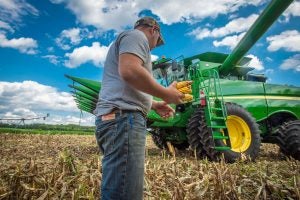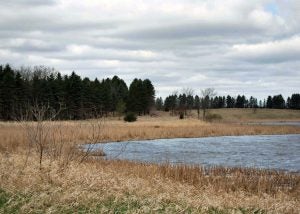Farmers are fiercely protective of their farmland. I remember making pacts with my brothers as small kids; no one would ever develop our family farm. The “home farm” is sacred. And there’s a surge of pride while belting the lyrics to Jason Aldean’s song about “the dirt we were raised on.” You better believe we’d meet them at the gate if they tried to put an interstate through our property.
So it’s not very surprising that farmers had a strong reaction to President Joe Biden’s executive order announcing his so-called 30×30 plan. The order asks several agency heads to work with stakeholders, including agricultural landowners, to develop a plan to conserve 30 percent of U.S. land and oceans by 2030. It also directs the U.S. Department of Agriculture secretary to figure out how current agency programs can be used to incentivize and assist farmers in adopting and implementing climate friendly technologies.
In short, the response sent people into a tizzy. The American Farm Bureau Federation, along with other agriculture groups, quickly asked for more information about the executive order. The underlying question is important. Where will the land set aside for conservation come from? Based on the order’s language, it certainly seems like currently tilled farmland could be in the mix. And, if it is, how is compliance obtained — voluntarily or by force?

Agriculture Secretary Tom Vilsack tried to calm the storm by suggesting that the USDA could assist with Biden’s goals by simply increasing the land in the Conservation Reserve Program. The CRP is a land-conservation program administered through the Farm Service Agency. In exchange for an annual rent payment, farmers agree to remove environmentally sensitive land from production. Instead farmers are required to plant species that will improve environmental health and quality on that land. Land enrolled in the program usually stays there for 10 to 15 years. The USDA is currently working to increase the rates and incentives for farmers to sign up.
But that doesn’t really answer the question: Is the 30×30 plan voluntary? Or will farmers be forced to participate in CRP?
Then the administration released the America the Beautiful report. As it relates to agriculture, the report mentions the word “voluntary” an almost-amusing number of times. It really, really tries to emphasize that the initiative will be incentivized, voluntary, and respect private land ownership. In other words, it isn’t a land grab! You can get a feel for that in this statement:
President Biden has recognized and honored the leadership role that farmers, ranchers, forest owners, and fishers already play in the conservation of the nation’s lands, waters, and wildlife, and has made clear that his administration will support voluntary stewardship efforts that are already underway across the country’s lands and waters.
Despite these assurances though, there’s a couple concerns. First, America the Beautiful specifically mentions “targeted efforts” to protect at-risk species. While no one wants any species to go extinct, we’ve seen how these efforts have sometimes decimated farming communities, such as in the Klamath Basin. We can protect endangered animals, but let’s find solutions that work with farmers.

There’s also a reference to the 2023 Farm Bill. (It hardly seems possible that we’re already looking at another farm bill!) The agricultural and food-assistance legislation is increasingly contentious each time it comes up. And most farmers aren’t going to be comfortable with major changes that remove land from production. A voluntary provision doesn’t need much change to make it mandatory.
So although the administration wants to assure farm landowners that the 30×30 plan is no big deal, it’s easy to see why the ag community hasn’t let their guard down. That doesn’t mean we aren’t interested in conservation. There are already 22 million acres enrolled in CRP — all completely voluntarily! With better incentives and a local, targeted approach, there’s no doubt we can increase that amount and conserve more land. Whether that number reaches 30 percent or not, and whether that puts too much land out of production, is another story.
As always, I’d encourage farmers, ranchers, and others in agriculture to approach this plan with caution. So long as it remains voluntary, it may provide opportunities for farmers who are already conserving sensitive lands. And if it doesn’t? Then we’ll meet them at the gates.
Amanda Zaluckyj blogs under the name The Farmer’s Daughter USA. Her goal is to promote farmers and tackle the misinformation swirling around the U.S. food industry.



